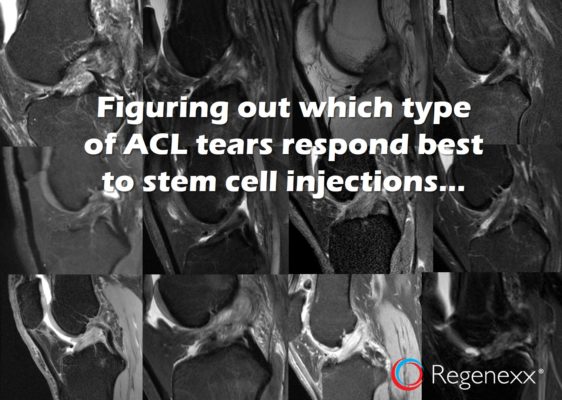Who Will Respond to an ACL Stem Cell Procedure?

©Regenexx
This weekend, I’ve spent hours and hours pouring over more than 50 before and after MRIs from patients who have received the ACL stem cell procedure we invented. This is the world’s largest collection of data to date on what happens when stem cells are precisely injected into ACL tears. I took a few of those images and crafted the collage you see above out of some of the before shots where patients got complete healing of their torn ACL. Why review all of these images? To find out who might fail this procedure and why.
Healing ACL Tears with Precise Stem Cell Injections
First, ACL surgery is invasive and doesn’t result in anything like the original equipment being replaced. While most patients believe that getting their ACL surgery means a new knee with a new ACL where the old one used to be, what they really get is a bunch of holes drilled in the bone and a tendon put in at the wrong angle to replace the torn ligament. This results in everything from high retear rates to poor position sense in the knee to an earlier onset of arthritis.
Way back in 2011, I thought about whether it would be possible to use imaging to precisely inject the patient’s stem cells into a partial ACL tear. After all, this could save the original ACL. After trying various methods, it turned out to be surprisingly difficult to accurately perform this injection. However, by 2012 we had begun to get it dialed in, and by 2015 we had it, for the most part, perfected. We published a small pilot study on ACL stem cell injections a few years back and have now submitted a bigger study for publication. We also continue to recruit for a randomized controlled trial.
One of the more amazing things is that despite the evolution of this ACL stem cell procedure, the retear and failure rates have been surprisingly small, much less than 10%. Initially, that was because we only tackled easily treated tears (partial ones), but as time wore on, we began treating bigger and bigger tears. However, when the novelty of seeing these tears heal on MRI wears off, it’s time to buckle down to let the data tell us who is and who isn’t a candidate for our ACL stem cell procedure. Hence, this weekend’s MRI fest.
Offset and Other Measurements
About two years ago on Linkedin, a smart radiologist mentioned that we might want to start measuring the offset of the femur relative to the tibia and that this could be helpful in looking at candidates for our procedure. The idea was that since the ACL prevented the tibia from moving forward on the femur, the more trashed ligaments, despite what they looked like on MRI, would allow more movement. This measurement would, therefore, help to quantify more damaged ligaments that might not respond. In general, these measurements seemed to work well, but confirmation bias is an interesting research gremlin. Meaning that thinking you know what’s happening without looking at the objective data can get you in trouble.
This weekend, while measuring each and every one of these MRIs, I noted that some of our successes had awfully big offset measurements, kind of putting a hole in my theory that these measurements were the sole key to defining candidates. While I was able to use some ratios that compensated for the fact that 7 mm of offset in a small woman’s knee was different from the same offset in a large man’s knee, there needed to be another parameter to create a model that could accurately predict patients who were highly likely to fail the therapy.
Morphology or How the ACL Looks
One of the things that became clear from my ACL MRI review was that how the ACL looks may be just as important for predicting who will respond to an ACL stem cell treatment as the offset. Thankfully, I was able to identify some configurations of the ACL that just aren’t compatible with a ligament that will heal.
Creating a Decision Matrix for Our Regenexx Providers
This next month, we’ll begin introducing our providers to a new decision tool that will help them predict if a patient is a good candidate for an ACL stem cell procedure. That tool will also be collecting data to grow smarter as the years progress. The goal is to continue to collect data so that after thousands of ACLs have been treated, Regenexx providers can predict with the highest accuracy possible who will respond and who should be told to skip the procedure.
The upshot? While experienced stem cell providers may have treated a handful of ACL tears with stem cells and consider everyone a candidate for this new procedure we pioneered, at Regenexx we’re moving beyond that into the next phase in any treatment—candidacy. Our new ACL stem cell procedure decision tool will be based on the world’s largest data set of successful and not-so-successful ACL procedures. It will grow smarter and smarter, allowing Regenexx providers to be the only group worldwide with an accurate crystal ball that knows whether you’re a candidate to skip invasive ACL surgery or not.

If you have questions or comments about this blog post, please email us at [email protected]
NOTE: This blog post provides general information to help the reader better understand regenerative medicine, musculoskeletal health, and related subjects. All content provided in this blog, website, or any linked materials, including text, graphics, images, patient profiles, outcomes, and information, are not intended and should not be considered or used as a substitute for medical advice, diagnosis, or treatment. Please always consult with a professional and certified healthcare provider to discuss if a treatment is right for you.